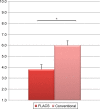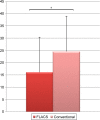Outcomes study between femtosecond laser-assisted cataract surgery and conventional phacoemulsification surgery using an active fluidics system
- PMID: 29026283
- PMCID: PMC5627560
- DOI: 10.2147/OPTH.S136136
Outcomes study between femtosecond laser-assisted cataract surgery and conventional phacoemulsification surgery using an active fluidics system
Abstract
Purpose: The purpose of this study was to compare intraoperative parameters between femtosecond laser-assisted cataract surgery (FLACS) and conventional phacoemulsification using Centurion® Vision System with Active Fluidics.
Setting: This study was performed at Brasília Ophthalmologic Hospital, Brasília, Federal District, Brazil.
Patients and methods: This was a prospective randomized comparative study. Patients with the diagnosis of cataract and surgical extraction programmed were divided into two groups: conventional phacoemulsification and FLACS. Intraoperative data were collected and submitted for statistical analysis.
Results: A total of 400 eyes were enrolled, 200 in each group. There were no surgical complications. Groups were statistically equivalent in age and nucleus density. Cumulative dissipated energy and torsional time were significantly reduced in the FLACS group. Conventional surgery had less fluid usage, total case time and aspiration (ASP) time.
Conclusion: FLACS with Active Fluidics System can reduce the ultrasound energy use during cataract surgery, in spite of increasing case time, fluid usage and ASP time.
Keywords: FLACS; aspiration; ultrasound.
Conflict of interest statement
Disclosure None of the authors has a financial or proprietary interest in any material or method mentioned. The authors have no affiliations with or involvement in any organization or entity with any financial interest or nonfinancial interest in the subject matter or materials discussed in this manuscript. The authors report no other conflicts of interest in this work.
Figures




References
-
- Han YK, Miller KM. Heat production: longitudinal versus torsional phacoemulsification. J Cataract Refract Surg. 2009;35(10):1799–1805. - PubMed
-
- Christakis PG, Braga-Mele RM. Intraoperative performance and postoperative outcome comparison of longitudinal, torsional, and transversal phacoemulsification machines. J Cataract Refract Surg. 2012;38(2):234–241. - PubMed
-
- Solomon KD, Lorente R, Fanney D, Cionni RJ. Clinical study using a new phacoemulsification system with surgical intraocular pressure control. J Cataract Refract Surg. 2016;42(4):542–549. - PubMed
LinkOut - more resources
Full Text Sources
Other Literature Sources

